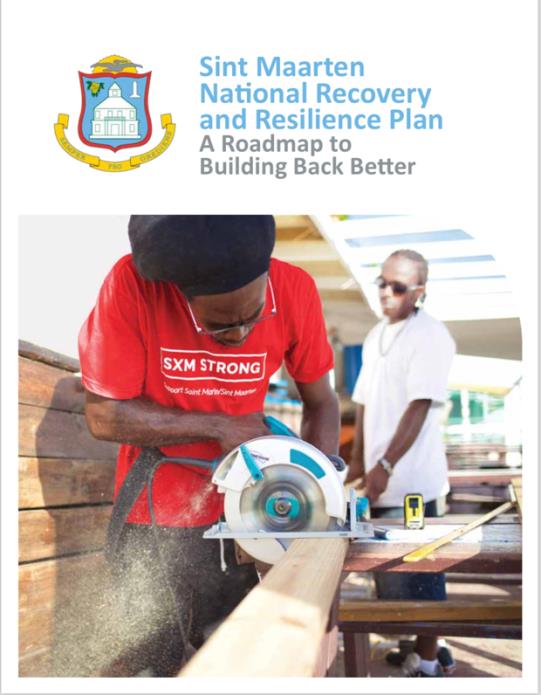PHILIPSBURG, June 21, 2018 – Madam Chair,
After months of intensive preparations, I’m pleased to present two important documents to Parliament today: (1) the National Recovery and Resilience Plan of Sint Maarten, and (2) the Temporary Ordinance on the National Recovery Program Bureau.
Before introducing the NRRP and the Temporary Ordinance, I would like to take this opportunity to express my gratitude to all the civil servants, the representatives of the World Bank and the many different stakeholders who contributed to the preparation of the NRRP.
In line with the unprecedented nature of Hurricane Irma, the NRRP is the product of a unique level of collaboration. I am very proud of my fellow Sint Maartener’s and especially the civil servants of each of the seven ministries who played a leading role in drafting this Plan.
I hope that the members of Parliament have studied the NRRP in detail, and that they can agree with the Government’s view that this is a thorough and knowledge-based document. The NRRP is prepared by more than 170 national and international experts that have collected, validated and analysed data on the damages, losses and needs in the aftermath of Hurricane Irma.
Based on site visits and consultations, the NRRP quantifies the recovery and resilience needs in 18 different sectors. It puts numbers and a plan to a reality that we know: as a country we have a lot of work to do.
We need to strengthen our infrastructure, our economy and our institutions – not just to recover, but to avoid a repeat of the devastation brought by Hurricane Irma.
The NRRP tells us what we need to do, as a country, to build back better. This is the roadmap for our ongoing recovery process – a process that began the day of the storm and will require our undivided attention for years to come.
Madam Chair,
Let us not be mistaken. We cannot pretend to return to business as usual. Sint Maarten’s recovery process will take a lot of time and energy, we cannot do everything at once. “Recovery is not a sprint, it’s a marathon”.
As a country we do not have the absorption capacity and the money to rebuild what we lost, in a few months or even a few years. The NRRP foresees a very ambitious recovery process, which will take at least five to seven years, that is, if Sint Maarten is not confronted with another major hurricane.
As stated in the NRRP, the Government of Sint Maarten and the World Bank estimates total damages and losses from Hurricanes Irma and Maria at 2.7 billion US dollars. The NRRP estimates that about 2.3 billion will be required for recovery and resilience interventions over the next seven years.
The NRRP guides us as a Government on what we should do as a country. However, the reality remains, that no one, including Government, can spend money that we do not have. At this moment, the Government the country of Sint Maarten do not have all the necessary funding to finance the whole NRRP.
There is a significant gap between the 2.3 billion in the NRRP and the currently available funding. As Interim Prime Minister, the Government’s highest priority has been to ensure that the Trust Fund of the World Bank would be established and that the available funding of the Netherlands would be secured – something that was uncertain when this Government came into office earlier this year.
This Government has ensured that 580 million US dollars will become available to Sint Maarten in the coming years. This will be our biggest source of funding – which we can only access by following World Bank procedures. I acknowledge that these procedures do take some time and can be frustrating but is necessary in order to obtain the funds.
In addition to the Trust Fund, the second major source of funding for now will be insurance payments for property. These are estimated to ultimately total between 320 and 430 million US dollars. Together the Trust Fund and insurance pay-outs will cover, in the best case scenario, about 50% of the identified needs in the NRRP. This leaves a major funding gap of at least 1 billion US dollars.
Madam Chair,
Our common task, as the Government and representatives of the people of Sint Maarten, is to find additional funding to narrow this gap. This funding could partly come from the national budget, by reducing costs and increasing revenues. Other important sources of funding can come from public-private initiatives and additional support from the Kingdom and the International community.
Meanwhile, the Government of Sint Maarten cannot spend money that we do not have. This makes clear that we need to find more money, but also that we need to prioritize.
Madam Chair,
What needs to be done first? The NRRP categorizes proposed interventions in four phases: immediate, short, medium and long-term. The top priorities of the NRRP, and the Government of Sint Maarten, are straight-forward:
One, the basic needs of the people of Sint Maarten – such as food, shelter, health and psychological care, education and livelihoods.
Two, to prepare the country as much as possible for the peak of the hurricane season. And three, to kick-start the economy.
Focus has been on vulnerable groups that need assistance to ensure they have a roof over their heads and a basic income to buy essentials. An immediate solution is being worked on to remove the debris left behind by Hurricane Irma and the wider issue of dump fires at the landfill. Plans are ongoing to repair Emergency shelters, strengthen emergency support services and assist public utilities with their recovery.
To restart the economy, the Government is working with the World Bank and the Netherlands on ways to support struggling small and medium-sized enterprises, and to ensure the continued reconstruction of our critical infrastructure, including the airport, hospital and hotels.
With the limited funds that has been made available, these are the priorities that the NRRP and the Government of Sint Maarten are focussing on, right now, in the first early projects that are being financed by the Trust Fund.
Madam Chair,
Making a plan and identifying funding is only part of the recovery process. Implementing projects takes more than money and good will: it takes time, capacity, material, knowledge, labour and undivided attention. This brings me to the second item on the agenda today, the proposed Temporary Ordinance on the National Recovery Program Bureau.
As a small island development state, Sint Maarten has limited resources. This creates particular challenges for project implementation. The reality is, that the Government of Sint Maarten does not have all the capacity and expertise to implement the different projects that will be financed by the Trust Fund. For these reasons, the temporary ordinance proposes to establish a National Recovery Program Bureau that will operate alongside the existing government organization.
Under the ordinance, the Bureau will be responsible for the implementation of the projects that will be financed by the Trust Fund. In all phases of these projects, the Bureau will work very closely together with the ministries. The Bureau is not there to replace the ministries, but to support the ministries as much as is needed to execute the projects in a successful manner and to build capacity in the existing organization.
The Bureau is financed by the Trust Fund and will be headed by a Director who is responsible for approximately twenty staff members that will assist the ministries with necessary requirements of Trust Fund projects, including financial management, procurement, as well as social and environmental safeguards.
Given the urgent need for additional support, the Government has already appointed a selection committee and they have begun recruiting the Director and the staff of the Bureau in a transparent manner. This selection process is ongoing.
Madam Chair,
Let me conclude. I count on all members of Parliament to recognize the NRRP as a knowledge-based document that will serve as the roadmap for the recovery process.
I have full confidence that this Parliament, as the representatives of the people, will acknowledge the necessity of additional capacity and will approve the Temporary Ordinance. This is urgently needed to ensure that the ministries receive the necessary support to implement the recovery and resilience projects.
Madam Chair,
This is what Sint Maarten needs, right now, to restore, secure and strengthen the well-being of our people.

